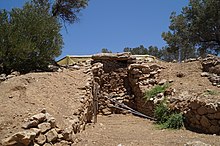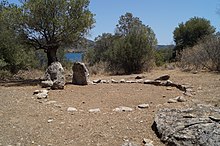Megali Magoula
Megali Magoula ( Greek Μεγάλη Μαγούλα , big hill ') is an archaeological excavation site near the Greek port city of Galatas . The excavations brought to light a Mycenaean dome tomb with dromos and other graves and sacrificial sites , as well as a Mycenaean acropolis . Some of these finds are exhibited in the archaeological museum of Poros .
discovery
At the beginning of the 1990s, nature and culture lover Stavros Kouvaris from Galatas discovered a conspicuous boulder on the Magoula Hill. He reported this find to the Greek archaeologist Eleni Konsolaki-Giannopoulou , who then tried to find the means for the excavation. From 1995 to 1997 and from 1999 to 2000 Eleni Konsolaki-Giannopoulou carried out excavations and discovered the Acropolis and three dome tombs. The boulder was a capstone over the drom of the great Tholos tomb.
Description and history
The approximately 70 m high limestone hill is located two kilometers west-northwest of Galatas across from the islands of Poros and Kalavria . It has a west-east extension of about 800 m and a north-south width of about 250 m. The Acropolis is located on the highest point from which one has a view of the Gulf of Poros and the two straits between the Peloponnesian mainland and the island of Kalavria. There is a small natural harbor about 150 m north. Due to this favorable location, the hill was settled early in human history.
In the meantime there is a small sign to the Acropolis on the road from Galatas to the north.
acropolis
During the Middle Helladic period there was a flourishing settlement of about 0.1 hectare on the highest elevation . It was surrounded by an elliptical wall of unworked stone. The upper construction of the wall probably consisted of unfired clay bricks . The access to the Acropolis was in the north. The remains of houses from this period were found within the walls and on the north and south slopes. The buried body of a child was found under the floor of a house on the Acropolis. The settlement was probably connected to Kolonna on Aegina .
Mainly Middle Helladic and only a few Late Helladic ceramic fragments were found on the Acropolis . Either the Acropolis was not settled in the late Helladic period or the top layer was removed later. In the late Classical Period , the place was repopulated and surrounded by a wall of hewn stones. A round tower was built at the western and eastern ends.
Dome tombs
To the west of the Acropolis, the Greek archaeologist Eleni Konsolaki-Giannopoulou discovered the remains of several Mycenaean domed tombs.
Grave 1
Tomb 1 is about 200 m northwest of the Acropolis. It is a tholos grave with a tholos diameter of 11.40 m and was probably about 11 m high. The access ( dromos ) was fortified on the right and left by walls made of unworked stones. The facade and the doorway ( stomion ) were built from large, uncut stones in a Cyclopean style, in which the spaces between the stones are filled with small stones. Only one of the original at least two cap stones has survived. The lower part of the Tholos was also made with large, uncut stones in a Cyclopean style . Smaller, flat stones were used in the upper part. The floor was strewn with pebbles. A burial mound with a diameter of about 45 m was poured over the grave, which was supported by a surrounding wall made of unworked stones.
The grave was robbed in ancient times. Sufficiently richer grave goods were found, however, which testify to the outstanding position of the corpse buried here. In addition to ceramic vessels, jewelry made of gold, faience and glass, arrowheads made of stone and three bull figures made of terracotta were found . The additions date from 1450–1190 BC. Chr. (SH II B - SH III B). The construction of the Tholos is reminiscent of the Cyclopean tomb of Mycenae , which was built around 1500 BC. BC (SH II A early) was built. Ceramics from MH III - SH I were found in the earth of the burial mound.
At a conference on July 2, 2006 on the volcanic peninsula of Methana , Eleni Konsolaki-Giannopoulou presented her discovery and suggested that it might be the tomb of the mythical hero Theseus , who is said to have defeated King Minos and the monster Minotaur in Crete .
Grave 2
Grave 2 lies under a protective roof about 133 m northwest of the Acropolis. It has a diameter of only 3.80 m. Access is just a hole dug in the rock before the stomion. The burial chamber was also dug into the rock up to the height of the lintel. The gateway and tholos were made of flat stones with clay. The tomb was robbed in antiquity and reused in the Hellenistic period . In addition to ceramics from SH II and a lens-shaped seal, ceramics from MH III - SH I were found, which probably originally came from the burial mound. Here, too, the ground was littered with pebbles.
Grave 3
Tomb 3 is about 100 m northwest of the Acropolis. It was built completely above ground and had a diameter of 3.90 m. Of the grave, however, only the door posts and the lowest row of stones of the grave dome have survived. The dome was likely built from lighter materials such as wood and clay. Fragments of ceramic cups and goblets from the period MH III - SH II were found. In addition, two bronze weapons were found: a tongue-shaped dagger and a type A sword. This grave is the oldest Tholos grave in the Eastern Peloponnese.
meaning
The excavations confirm the observation made earlier that the beginning of the Mycenaean culture does not coincide with the beginning of the Late Helladic period, but in some regions already begins in the Middle Helladic period. The Saronic Gulf region was an important center of the Mycenaean civilization and perhaps even the true origin of this culture.
The discovery of the Mycenaean sanctuary on Methana in 1990 shows that the Troizen region , which was considered the birthplace of the mythical Theseus, must have been a center of Mycenaean high culture in the Mycenaean period . Over 150 clay idols and a children's grave were discovered there. Finds are exhibited in the Poros and Piraeus museums . Other Mycenaean sites in the region are on Aegina and near Pano Fanari. On the Methana peninsula and in the region there are numerous prehistoric farms and their equipment (oil or wine presses, mills) in the mountains.
Web links
- Megali Magoula - Galatas. Retrieved September 7, 2014 . (PDF file)
- Structural analysis of the tholos tombs at Megali Magoula, Galatas (Troezenia). Retrieved September 7, 2014 .
Coordinates: 37 ° 30 ′ 8.1 ″ N , 23 ° 25 ′ 22.3 ″ E




